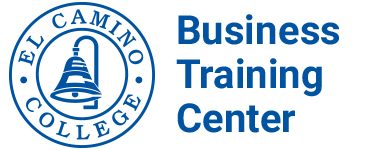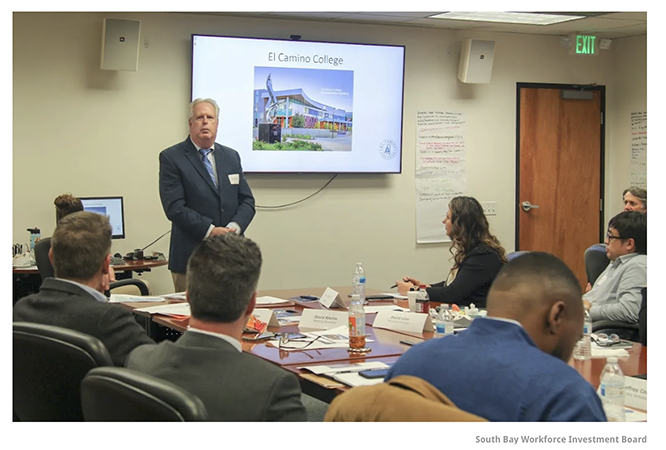Photo: Eldon Davidson, Director, Advanced Customized Training Solutions at El Camino College makes a presentation to officials from NASA and the Aerospace Industries Association. Representatives from private companies such as Northrop Grumman, Boeing, SpaceX, Virgin Galactic, Morf3D, Stellant Systems, Rocket Lab and Relativity Space were in attendance.
From the Daily Breeze
A White House initiative to train and recruit employees for the space industry has been growing with success, according to the federal government’s Southern California program partners.
“We’re really excited about this,” said Jan Vogel, executive director and CEO of the South Bay Workforce Investment Board.
Vice President Kamala Harris announced the “White House Space Industry Coalition” initiative in the fall, an effort aimed at developing a “skilled and diverse” space workforce to address the labor shortage pinching the aerospace industry, according to a White House press release.
To better meet its goal, the White House enlisted the help of the public, private and philanthropic sectors. Specifically, it picked four organizations, Blue Origin, Boeing, Lockheed Martin and Northrop Grumman, to lead a coalition of space companies across the country.
The responsibilities of the coalition include, in part, setting up three regional pilot programs in Florida’s Space Coast, the Gulf Coast of Louisiana and Mississippi, and Southern California, according to the White House release.
The Southern California coalition, anchored by Northrop Grumman, is already up and running. The group recently met in-person for the first time at the South Bay Workforce Investment Board’s corporate headquarters in Hawthorne
Officials from NASA and the Aerospace Industries Association attended the meeting. They were joined by representatives from private companies such as Northrop Grumman, Boeing, SpaceX, Virgin Galactic, Morf3D, Stellant Systems, Rocket Lab and Relativity Space, as well as those from El Camino College and Cal State Dominguez Hills.
“Basically, NASA is projecting a large shortage in technicians to work on projects that would be space related,” Vogel said, “and the need to create a pipeline for new employees to be able to access employment that will benefit NASA and the space program.”
David Ritchie, who’s in charge of an apprentice program for budding machinists at Northrop Grumman, said an aging workforce across the industry has resulted in an urgent need to train and recruit new skilled workers.
“(There are) a lot of baby boomers in there, which includes me, by the way,” he said, “and we need to get some new talents in here that’s gonna carry on the work we do.”
Due to declining population growth and various other factors, such as the aging of the baby boomers, the labor participation rate has continued to decline. A quarter of the current workforce, in fact, will be older than 55 by 2024 and among those, a third will be at least 65, according to an estimate by the U.S. Bureau of Labor Statistics.
The shift in labor force demographics has taken a particular toll on the aerospace and defense industries, which experienced an exodus of talent during the pandemic.
Almost 47% of people said the turnover rate at their companies have significantly increased during the last 12 months, according to a workforce study released in October by the Aerospace Industries Association and the American Institute of Aeronautics Astronautics, in collaboration with Ernst & Young.
And 78% said the reason for people leaving their jobs was the chance at a higher salary, with 75% also citing better career advancement as the reason for the high turnover, and 31% citing flexibility in work location and opportunity for remote work as the cause for departure.
The labor shortage came at a time when companies are ramping up production because of an increase in customer demand during the post-pandemic rebound. Russia’s invasion of Ukraine has further deflated the U.S.’s defense spending.
That’s where Northrop Grumman’s apprenticeship program came in. That program began 30 years ago, when the company saw the need to train its employees with the skills that it desired, Ritchie said.
Through its partnership with El Camino College, for example, the program brings in interested students for an eight-week trial period. After that, select applicants are offered a four-year apprenticeship that includes one-on-one training with advanced machinists at the company.
Ritchie said he believes the company’s long-standing apprenticeship program was partly what motivated the White House to select Northrop Grumman as the regional anchor.
Although there’s already a developed curriculum for STEM programs — science, technology, engineering, math — at most colleges and universities, it’s difficult to market these programs to companies, said Jose Anaya, dean of community advancement at El Camino College.
“By having the White House initiative, the companies are coming together and we’re able to speak to all of them about the wonderful programs that we have,” Anaya said. “Rather than go to each individual, we can talk to them as a group and showcase our programs and how they can connect with us to develop apprenticeship programs of their own.”
Some students at El Camino College are also on the STEM pathway and many of them come from historically underserved and underrepresented communities. They are the ideal student base to fulfill the White House initiative, which emphasizes skilled job seekers from diverse backgrounds, Anaya said.
Vogel, for his part, said the next step for the coalition, which first met on March 16, is to develop training programs to be implemented across institutions and workforce centers in Southern California
The need, officials said, is higher than ever.
“There is a lot of work in this industry,” Ritchie said, “and we need qualified people.”
###

